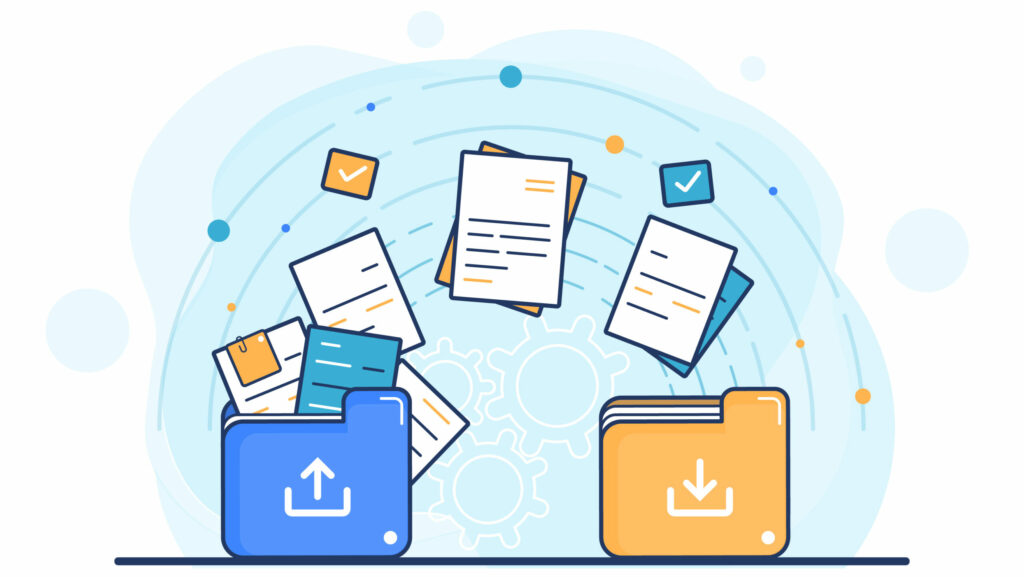Contract migration is an essential process for businesses looking to streamline their contract management and maximize efficiency. As companies grow and evolve, their contract portfolios often become outdated and difficult to manage. When old contracts are kept in different ways, like on paper or in different computer systems, it can make managing them hard and cause problems with following the rules. That’s where contract migration comes in.
Contract migration involves transferring old contracts to a new system or format, typically a contract lifecycle management (CLM) system. Moving contracts to one main contract system helps organizations have just one place where all their contracts are kept. This makes managing contracts easier and simpler.
The process of contract migration requires careful planning, organization, and attention to detail. This process includes looking at how contracts are managed now, figuring out what tools and things are necessary, and making a plan to move everything smoothly. First, you take stock of all the contracts and put them in order.
Then, you turn paper contracts into digital files, check and fix any mistakes in the contract info, and plan how to move everything. After that, you put the plan into action, making sure everything goes as planned. Finally, you review how things went after the move and check that everything’s working okay.
While contract migration can be complex, it offers numerous benefits for businesses. It improves contract visibility, reduces administrative work, enhances compliance and risk management, and provides a centralized repository for all contracts.
Understanding Contract Migration and CLM Software

Contract migration is the process of transferring old contracts from various sources to a new system or format. It is a crucial step in implementing contract lifecycle management (CLM) tools and streamlining contract management processes. Legacy contracts kept in different ways, like on paper or in different computer systems, can make it hard to find them, search through them, and make sure they follow the rules. challenges in terms of accessibility, searchability, and compliance.
Contract migration involves organizing and digitizing existing contracts, transferring data to the new system, and ensuring accuracy and completeness. It requires careful planning, attention to detail, and the use of essential tools and resources to ensure a successful migration process.
The Basics of Contract Data Migration
Contract migration is an integral part of implementing contract lifecycle management (CLM) tools. CLM software provides a centralized and unified platform for managing contracts, enabling organizations to streamline their contract management processes and ensure compliance.
The contract migration process starts with assessing the current contract management system and identifying any gaps or inefficiencies. This includes evaluating the tools and resources currently in use and determining if they are suitable for the migration process.
Legal teams are really important in moving contracts from one system to another. They look at and sort out existing contracts, making sure all the information is correct. They also plan how to move everything and work with other teams like finance and IT to make sure everything goes smoothly.
Special software for contract management, called CLM software. Volody’s CLM software, specifically designed for contract management, is a game-changer when it comes to moving contracts efficiently. It does things like getting information out of contracts, analyzing them, and managing where they’re kept. These tools help legal teams move old contracts to the new system quickly and without problems, making sure the move goes well and setting things up for better contract management in the future.
Related Article: How To Digitize Your Physical Contracts?
Why Migrating Contracts Is Crucial for Modern Businesses?

Moving contracts is really important for today’s businesses for a few reasons. Most importantly, it lets organizations put all their contract info in one place, so there’s just one spot where everyone can find the right details. This makes it easier to keep track of important contract stuff, like how much the contract is worth and when it needs to be renewed.
Additionally, migrating contracts to a new CLM system enables organizations to streamline their contract management processes. It makes managing contracts easier, so legal teams have more time to focus on important jobs.
From a business planning perspective, migrating contracts provides valuable insights into contractual obligations and revenue forecasting. When all contracts are in one central spot, organizations can quickly get and study contract information. This helps them see trends and patterns that can guide important decisions.
Overall, migrating contracts to a new CLM system not only improves contract management efficiency but also enhances compliance, reduces risk, and provides a solid foundation for future growth and success.
Related Article: 5 Benefits Of Implementing A CLM Software
Preparing for Contract Migration

Preparing for contract migration is an important step to ensure a smooth and successful migration process. It involves several key considerations and actions.
First, businesses need to check their current contract system and see if there are any problems that need fixing. This means looking at what the current system can do and deciding if they need a new contract system.
Secondly, organizations should gather the essential tools and resources needed for contract migration. This includes contract management software, data extraction tools, and any other necessary technologies or services. These tools will facilitate the extraction, organization, and migration of contract data.
Lastly, it is important to involve key stakeholders in the preparation process. This includes legal counsel, IT teams, and other relevant departments. Working together with these people will make sure that everything to do with moving contracts is sorted out and that everyone gets the help they need during the process.
Essential Tools and Resources Needed
Successful contract migration requires the use of essential tools and resources to facilitate the process. These tools and resources are crucial for extracting, organizing, and migrating contract data efficiently.
One essential tool is contract management software, which provides a centralized platform for storing, managing, and analyzing contracts. This software streamlines the contract migration process by allowing users to digitize and organize contracts, extract key data points, and automate contract administration tasks.
Additionally, data extraction tools are crucial for extracting relevant information from legacy contracts. These tools use advanced technologies such as natural language processing (NLP) and optical character recognition (OCR) to extract data accurately and efficiently.
Other resources that may be needed include project management software to facilitate collaboration and organization, as well as data cleansing tools to ensure the accuracy and integrity of the migrated contract data.
Assessing Your Current Contract Management System
Before embarking on the contract migration process, it is important to assess your current contract management system.
Evaluate the capabilities of your current system and determine if it meets your organization’s needs in terms of contract organization, accessibility, and reporting. Consider whether it provides a single source of truth for all contracts and related data.
Additionally, assess the level of automation and artificial intelligence (AI) capabilities provided by your current system. AI-enabled contract management platforms can greatly enhance contract migration by automating data extraction, contract analysis, and reporting.
By checking your current way of managing contracts, you can see if there are any problems and decide if you need a new contract system to help move contracts successfully. A strong contract system with smart technology and one central place for information will make moving contracts easier and help manage contracts better in the future.
Related Article: Best Contract Management Software: Top 10 CLM In 2024
A Beginner’s Guide to Contract Migration

Inventory and Organize Your Existing Contracts
Create a comprehensive list of all current contracts, including their types, renewal dates, and relevant data points for a successful migration process. Efficiently categorize them based on contract value and importance.
Utilize a systematic approach to organize physical or digital contracts for easy access and extraction. This initial step lays the foundation for a streamlined contract migration process, ensuring no contract is overlooked. By establishing a structured inventory, you pave the way for a smooth transition to a new CLM system.
Digitize Paper Contracts and Centralize Storage
To effectively digitize paper contracts and centralize storage, leverage advanced CLM software to convert physical contracts into digital formats. Utilize artificial intelligence for data extraction, ensuring all relevant information is captured accurately.
Centralize storage on a secure CLM platform to create a single source of truth for easy access and management. Implement strict access controls and security standards to safeguard contract data. This step streamlines processes, enhances efficiency, and mitigates risks associated with manual handling.
Cleanse and Validate Contract Data
Data cleansing and validation are vital steps in the contract migration process. Ensure accuracy by removing inconsistencies, errors, and redundancies from your contract data. Validate the information against trusted sources to guarantee its integrity.
Utilize tools like automated data cleansing software to streamline this process efficiently. By carefully cleaning and checking your contract data, you make it easier to switch to a new contract system, making sure your moved contracts are reliable and good quality.
Map Out the Migration Process
To successfully migrate contracts, mapping out the process is critical. Begin by identifying all data points, contract types, and relevant information. Utilize your new CLM system to outline the steps involved in transferring legacy contracts.
Consider contract value, renewal dates, and obligations during this phase. Mapping out the migration process ensures a smooth transition to your new system, establishing a single source of truth for all contract information. This strategic plan is key to a successful contract migration.
Implement the Migration Plan
Initiate the migration plan execution by allocating responsibilities to team members based on their expertise and ensuring clear communication channels. Set milestones to track progress accurately and address any issues timely. Utilize advanced permission controls to restrict access as needed, maintaining data security.
Implement the plan systematically, ensuring each step aligns with the overall migration strategy. Regularly monitor the migration process, making adjustments as necessary to ensure a smooth transition. Successful implementation is key to a seamless contract migration process.
Conduct Post-migration Review and Audits
Once all the contracts have been moved, it’s really important to check that everything got moved correctly. This means looking at the data to make sure it’s all accurate and complete. This step involves meticulously examining the migrated contracts, comparing them against the original data, and conducting thorough audits to address any discrepancies.
By doing these checks after moving contracts, you can find and fix any problems, making sure the moving process goes well and there aren’t any mistakes. Conducting these reviews and audits serves as a final quality check to validate the integrity of the migrated contracts.
Related Article: Digitizing Legacy Contracts: Best Practices
Measuring the Success of Contract Migration

Tracking the success of contract migration is vital to gauge its efficacy. Key Performance Indicators (KPIs) play a crucial role in this evaluation. Monitoring factors such as data accuracy, migration timeline adherence, and system downtime can provide valuable insights.
Additionally, gathering feedback from users and stakeholders helps in identifying areas for improvement post-migration. Continuous evaluation and adjustments ensure a smooth transition and maximize the benefits of the migration process.
Key Performance Indicators (KPIs) to Track
To measure the success of contract migration, tracking key performance indicators (KPIs) is essential. Important things to keep an eye on include how accurate and complete the moved data is, if the moving happens on time, how much the system is offline during the move, and if people like the new system.
Watching these numbers helps see how well the moving process is going, find places to make it better, and make sure changing to the new contract system goes well.
Gathering Feedback and Making Adjustments
Upon completing contract migration, gathering feedback and making adjustments are crucial steps for refining the process. Soliciting input from stakeholders and end-users helps pinpoint areas that require fine-tuning. Analyzing feedback enables you to identify patterns and areas of improvement for future migrations.
Iterative adjustments based on feedback foster continuous enhancement of contract migration practices, ensuring smoother transitions and optimized outcomes. Regular feedback mechanisms maintain alignment with evolving business needs and technological advancements, enhancing the efficiency and effectiveness of contract migration processes.
Related Article: Top 7 Contract Management KPIs For Success
Frequently Asked Questions
What Are Common Pitfalls in Contract Migration and How Can They Be Avoided?
Common mistakes in moving contracts include not cleaning the data well enough, not planning out the move carefully, and not checking everything afterwards. To avoid these problems, make sure to check the data really well, plan out exactly how the move will happen, and look over everything carefully once it’s done. Using special tools that do things automatically can make these tasks easier and quicker.
How Long Does a Typical Contract Migration Process Take?
The time it takes to move contracts varies widely, typically spanning from a few weeks to several months. Several factors influence this duration, such as the volume and complexity of contracts, as well as the tools employed for the migration process. For instance, if there are a large number of contracts or they are highly intricate, it will naturally take longer to transfer them.
Additionally, tasks like cleaning up data, ensuring its accuracy, and ensuring compatibility between systems are crucial steps that can extend the migration timeline. Taking the time to thoroughly prepare and validate data before migration is essential to minimize errors and ensure a successful transition. Moreover, the efficiency of the tools and technologies used for migration can significantly impact the speed and effectiveness of the process.
Can Contract Migration Improve Contract Compliance and Risk Management?
When contracts are moved to a centralized location, it becomes simpler to ensure compliance with regulations and agreements. This consolidation allows for easier monitoring and validation of contract terms and conditions.
By having all contract data in one place, organizations can quickly identify any discrepancies or potential issues, enabling prompt action to mitigate risks. Additionally, centralization enhances visibility and control over contractual obligations, facilitating better management of deadlines, deliverables, and responsibilities.
What Should Be Done with Legacy Contracts Post-Migration?
Once contracts have been moved, it’s important to decide what to do with the old ones. You can keep them for reference by putting them away or turning them into digital files. This way, you can still access old information if you need it. Check if these old contracts still matter and follow the rules of the new system to decide if you should keep them or get rid of them.
Conclusion
In conclusion, successful contract migration is pivotal for modern businesses to streamline operations and enhance efficiency. By following a structured approach that includes inventorying contracts, digitizing data, and implementing a migration plan, organizations can mitigate risks and ensure compliance.
Leveraging technology, clear strategies, and ongoing training are key to a seamless transition. Monitoring KPIs, gathering feedback, and making necessary adjustments post-migration is crucial for long-term success. Understanding common pitfalls and investing in security measures are essential for a smooth migration process.
Embracing best practices can lead to improved contract compliance and risk management, ultimately driving business growth and sustainability.





